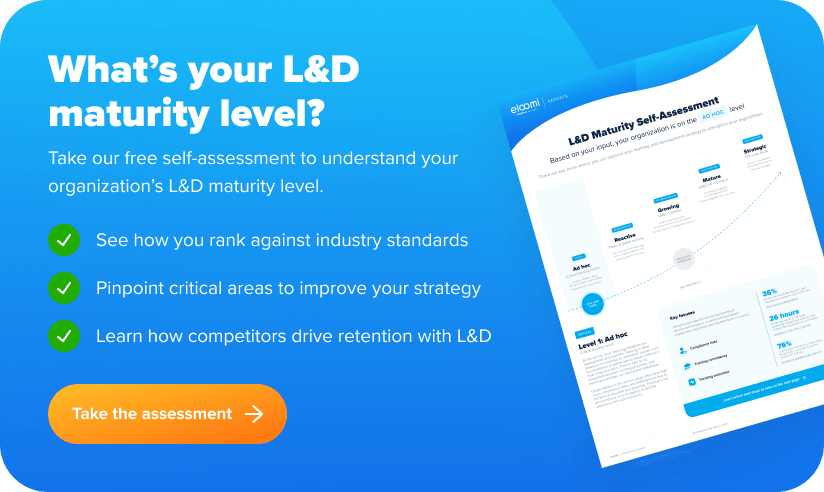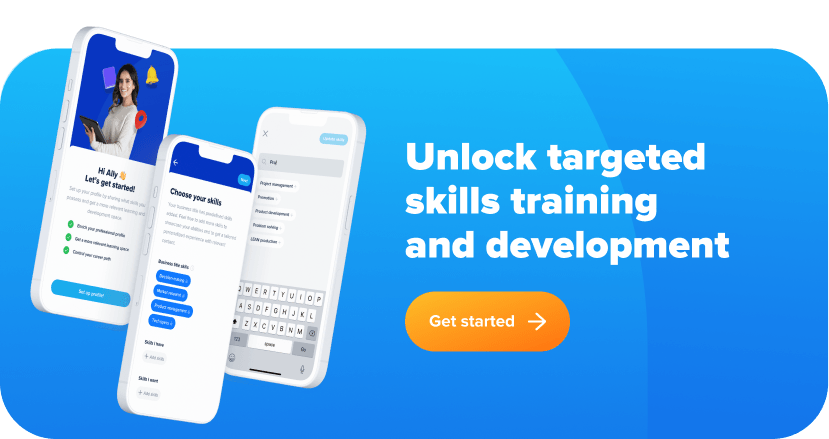What is upskilling and reskilling?
Upskilling and reskilling refer to improving your skills and filling in the skills gaps, whether in professional or personal career development to reach your goals.
A basic definition of upskilling is to move up the skills ladder by gaining advanced knowledge and abilities in a particular field. Reskilling is when you take what you already know and learn how to apply that knowledge or those abilities differently or in an entirely different field.
Both terms are used about the changing job market for various reasons. Technology is constantly evolving, and workers need to stay current with their skills to prepare for new jobs as they emerge. Another reason would be the increased AI automation, a challenge for emerging job opportunities.
In fact, according to the World Economic Forum’s reporting, at least 50% of all employees will need skill-building and improvements by 2025 as the need for adoption of technology increases.
In this article, we will discuss the benefits of upskilling and reskilling your employees and how to implement the same within your business model.

Benefits of Upskilling and Reskilling Your Team
Upskilling and reskilling your team is a way to make your business more competitive, attract and help with talent retention, and provide a better work environment for your employees. Here are some of the key benefits:
More cost-effective than external hiring
A significant benefit of upskilling or reskilling initiatives is that it’s far more cost-effective than external hiring. Recruitment and onboarding costs can be significant, so the sooner you can get your team up to speed, the better. Upgrading your team’s skills allows you to access new markets and opportunities.
With the proper skills training, your employees can take on more complex projects and offer better customer service. This is especially true if you’re looking to expand your business, as new hires will need time to get up to speed with their roles and responsibilities. If they don’t have this, they’ll be less productive in the long run.
Read More: 3 Strategies To Build A Skills-Based Organization
Create stronger employee engagement
Employees must be continuously trained and developed to stay updated with the latest technologies, processes, etc. By upskilling employees, you create a conducive environment for innovation and get valuable input from the employees. This will help you to identify the most creative ideas, making your organization more productive and creative.
Creating a culture of learning can foster great collaboration and engagement in your team. Your employees will also take pride in their work as they contribute something valuable to the organization’s growth.
Open doors to new roles
With a growing number of customers choosing to interact with brands digitally, it’s essential that you invest in your employees. By upskilling employees and giving them the tools they need to fill their skills gaps, you can ensure they continue to provide excellent customer service while helping your business grow.
Training your current workforce to handle additional customer service roles will give them more flexibility and better equip them to handle customer demands in this evolving digital age.
When you upskill, your employees can take on new roles within their teams and departments or move into other company areas. This helps you expand your teams while reducing costs simultaneously.
Increase team collaboration
Increasing collaboration is one of the biggest benefits of upskilling and reskilling your team.
Soft skills like communication, empathy, and understanding are all elevated when everyone on the team has a shared vocabulary and understands how their work connects with the work of others. When employees are more comfortable in their jobs, they’re more likely to ask questions and offer suggestions to colleagues.
Even better, they’ll have the confidence to be creative and bring new ideas to the table, which can be a great initiative and generate exciting results.
Lastly, when all team members are engaged in conversations about their roles and responsibilities, they feel valued as an integral part of the organization.

How Businesses Can Upskill and Reskill Their Teams
For businesses to upskill or reskill their employees, they must first identify the skills they need. Businesses can do this by looking at the education and training of the current staff or by taking stock of what skills are lacking due to changing needs within the market. Here are some tips:
Mentoring and Job Shadowing
Mentoring and job shadowing are excellent ways for businesses to upskill and reskill their team. Mentorships can get junior team members up to speed on the business, and they can also be used to give senior staff valuable on-the-job training.
Job shadowing provides junior employees with direct learning experiences of a specific job and a way to pick up new skills they wouldn’t have if they only learned about the new position in theory. It involves watching a trained member of staff go about their work duties and taking notes on their processes or methodologies.
Online Training
When you’re looking to train employees, there’s no need to have them stay in the office. Online training programs can help your team master the latest software and industry best practices from wherever they are.
As a company, you can purchase a subscription to an on-demand learning experience platform or webinar service and invite your current employees to take the courses. This will help them with skills development in areas they feel lacking.
One of the best features of online training is that it can be accessed from anywhere. You can send your learners on courses while on business trips or even doing remote work. All they need is an internet connection and their laptop or smartphone.
Employee onboarding and compliance training are a few examples of training that can be done in this manner.
Blended Learning
Blended learning is a process that integrates traditional classroom learning with a more convenient and engaging way of learning. For example, a learner might take a course at their desk using the school’s online tools, then meet with a teacher for a weekly class. Employees can take the class as often as they want and from any location, meaning less time spent going to and from a school or being in a classroom.
The goal of blended learning is to help employees learn about topics that are relevant to their career path in ways that best fit their schedules—whether that means meeting with an instructor or teaching themselves via online courses and live classes. This approach to learning is not just an ideal way to upskill and reskill your team; it’s also a great way to save money.
Unleash Your Skills Potential with eloomi
For business owners looking to become more competitive, eloomi is the perfect solution. The eloomi LXP delivers an intuitive elearning experience to help your employees develop their talents and foster collaboration. We also allow you to track your success in measurable data. With the help of eloomi’s powerful analytics tools, you can easily track progress in real-time.
eloomi is the ultimate LXP for businesses, offering a wide range of features to help your business succeed. Its flexibility makes it stand out from the crowd—eloomi enables enterprises to use their data in ways that weren’t possible before.
In addition, with eloomi’s curated learning content, you can guide new employees to learn anything from the basics of a new product or service to highly advanced learning pathways. Each employee can be trained on their schedule and at their own pace.
Get started with eloomi now to kickstart your LXP journey and improve the learner experience!







